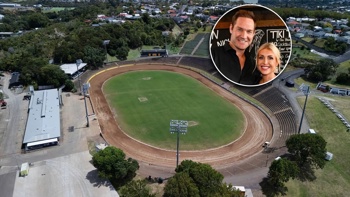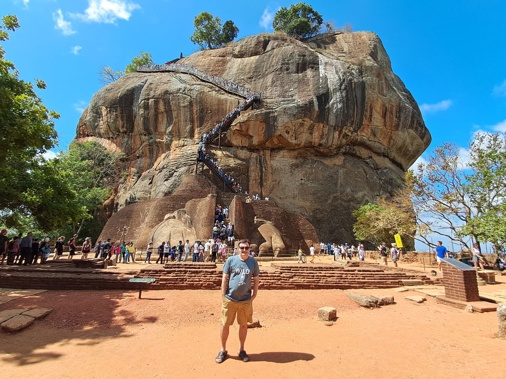
After savouring Sri Lanka’s western coast, the nation’s famed cultural triangle serves up a bevy of World Heritage ancient treasures in the heart of the island. Travelling with On the Go Tours, we farewelled the city buzz of Colombo and drove east for several hours to Dambulla, home to the spectacular Dambulla Rock Temple. Sri Lanka has a long history of the presence and practice of Buddhism and this sprawling cave complex is quite the treasure-chest. The Dambulla temple is not only one of the oldest sites for Buddhist monasticism, but it has served as a pilgrimage site for twenty-two centuries. The massive cave temple complex is unique in Southeast Asia because monks carved the caves out from rock, towering 160 metres above the surrounding plains. There’s more than 80 caves across the site, but the major attractions are spread over five caves which contain statues and paintings of Buddha and his life.
They’ve been in continuous use for over 2000 years and the five caves huddle under a vast overhanging rock, carved with a drip line to keep the interiors dry. Progressively enhanced over the centuries by a multitude of kings, the temple complex remains the best preserved ancient edifice in Sri Lanka. There’s over 150 Buddha statues, hewn out of the rock, throughout the caves, including the 14 metre-long reclining Buddha. Hindu deities are also represented. One cave has over 1,500 paintings of Buddha covering the ceiling, which flawlessly follow the contours of the rock. The sheer magnitude and intricacy of the craftsmanship is enthralling. If you’re visiting at twilight, the fading light attracts hundreds of swooping swallows to the caves entrance, which temporarily disrupted my Zen-like state!
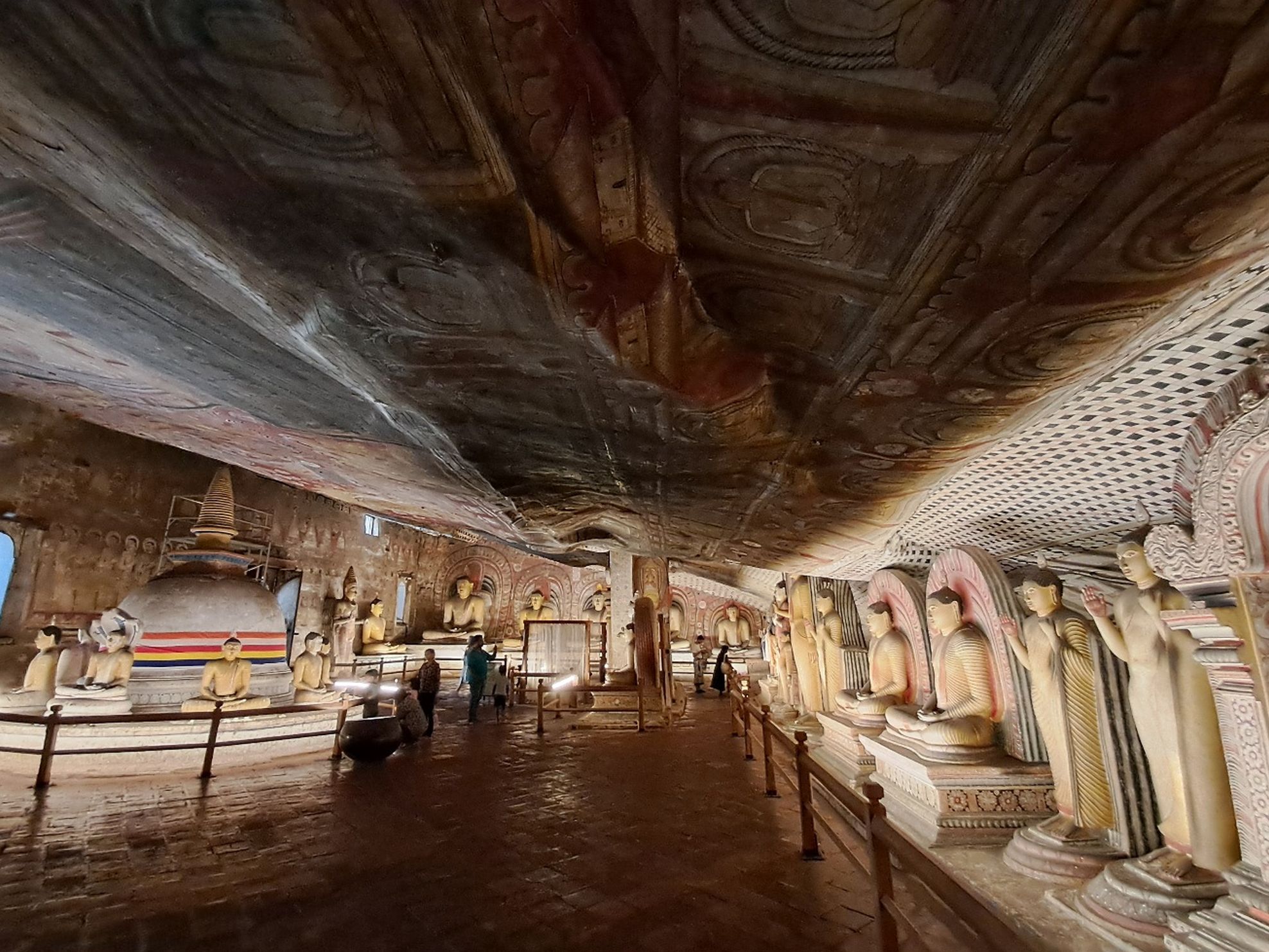
A short drive from Dambulla brings you to Polonnaruwa, which served as the ancient capital city 800 years ago, before the Sinhalese kingdom shifted its power base to modern-day Colombo. Back in the day, Polonnaruwa was a thriving commercial and religious centre, before being abandoned and consumed by the jungle. It’s like a mini-Angkor Wat. Now a restored World Heritage site and liberated from the jungle, the glories of that age are readily apparent in the archaeological park.
It’s a delight to explore with hundreds of ancient structures – tombs and temples, statues and stupas – in a compact core. The Quadrangle alone is worth the trip. Situated at the heart of the ancient city, the Quadrangle features the most important cluster of religious shrines. Its centrepiece is the flamboyant Vatadage, a superbly decorated circular shrine with a huge Buddha statue at its heart. Considered by many as the most ornate building in Sri Lanka, I was particularly struck by how the outer walls are carved with friezes of lions, dwarfs and lotuses. It’s drop-dead gorgeous.
As much as I enjoyed admiring the antiquities of this lost city, I was constantly distracted by the hordes of primates. So was Disney. Eulogised in Disney’s Monkey Kingdom movie, Polonnaruwa is home to a flourishing monkey population, living among the impressively preserved ruins. It’s the best place in the country to get up close with Sri Lanka’s three diurnal primates: the purple-faced leaf monkey, the toque macaque and the absurdly delightful tufted grey langur. They are all full of mischief, fearless and know how to work a room. The Smithsonian Primate Research Center has helped make this site a conservation sanctuary for these cartoonishly beguiling creatures.
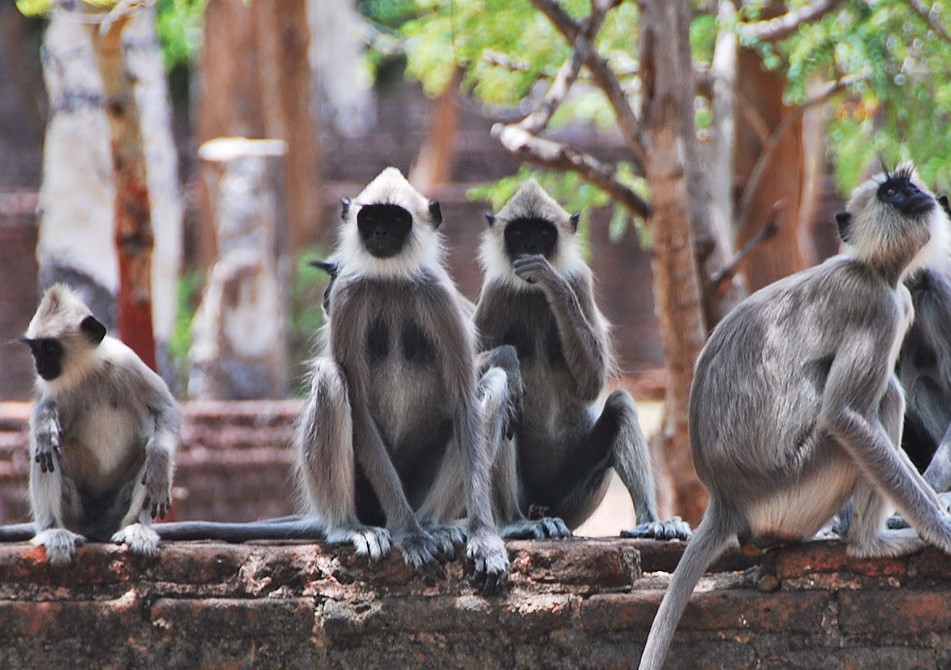
But before sweetly surrendering to more wildlife spectacles, there was another blockbuster ancient rock kingdom to explore. The shortest-lived but the most extraordinary of all Sri Lanka’s ancient capitals, Sigiriya Rock is a blow-your-hair-back experience. Better known as Lion Rock, this massive monolithic column of granite rock and its flat-top summit thrusts 200 metres high from the earth. It was turned into an ancient rock fortress 1500 years ago by King Kashyapa, who chose Sigiriya as the site of his new capital. It’s staggering to reflect on how such grand-scale engineering and design works were achieved, so long ago. He decorated the rock walls with 500 frescoes, and built a pleasure palace, accessible only through the mouth of a massive carved lion. How very James Bond!
The king was anxious to have a protective lair, given how offside he had become with his subjects. As it was, this crazy king who had overthrown his father to acquire the throne, and buried him alive, lost his life in a battle against his brother, several years later. We wended our way up the 1200 steps of passageways cut into the rock face between a monumental pair of lion paws, carved into this landmark, at the base of the stairway. (Thankfully, the British rebuilt the access stairways last century.) At one time, the stairs led through the open mouth of a lion’s head that crouched between the paws.
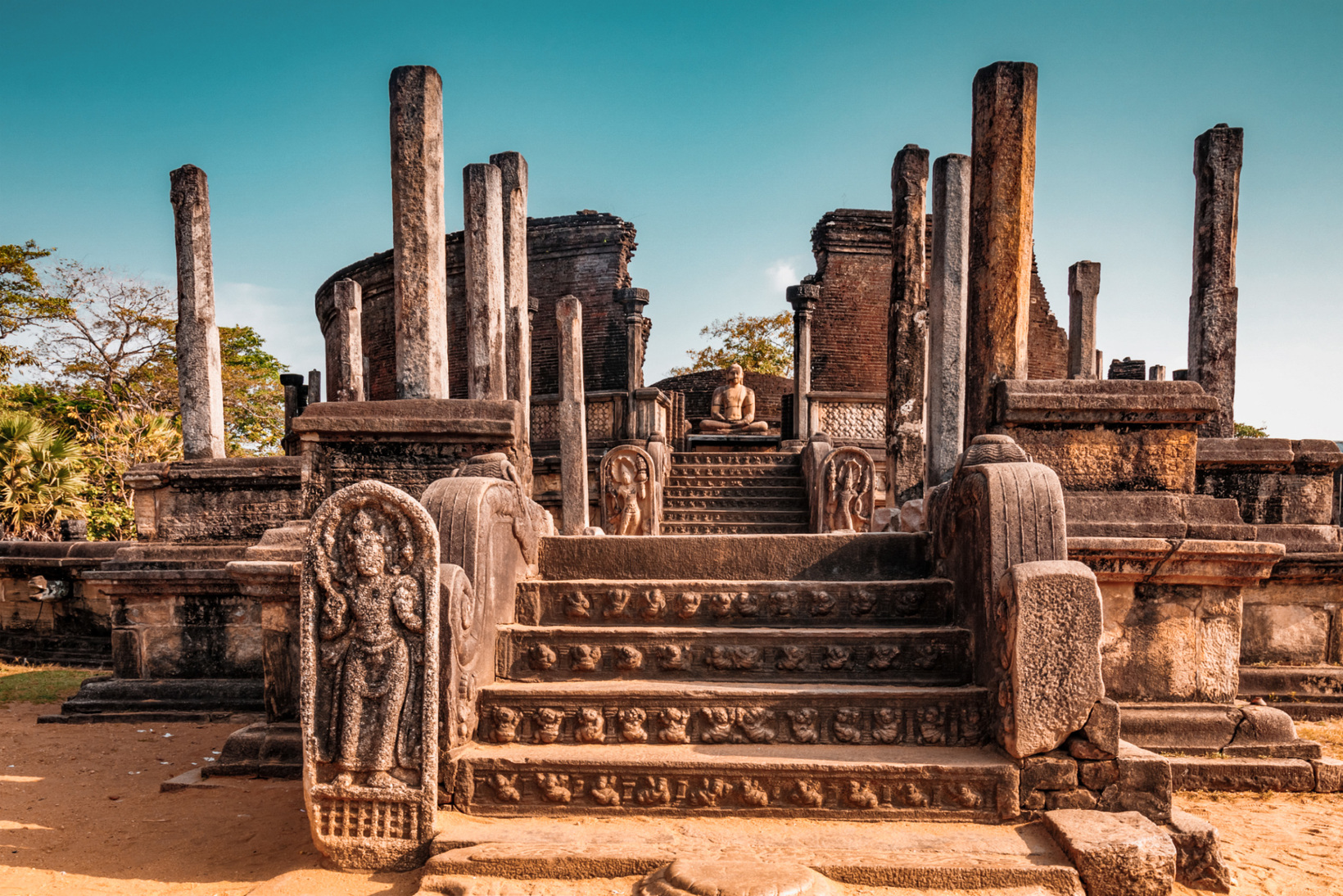
En-route to the top, a short detour leads to the magnificent Cobra’s Hood cave fresco gallery with semi-naked paintings of the king’s maids in waiting and women of the royal court draping flowers on mere mortals. Some historians claim he had 500 women to pleasure him! Jutting out from the rock, the Mirror Wall displays ancient transcripts that closely match the modern-day Sinhalese language. It was polished to perfection as the king often posed and preened himself as he walked past it, plus it reflected the painted ladies from Cobra’s Hood. After much puffing, we reached the top. The palace ruins can be seen on the lofty summit which have eroded over the passage of time, but it’s conquering this climb that is the real thrill.
Fanning out from the rock fortress, lush water gardens and bathing ponds accentuate the scenic appeal of this World Heritage site, as does the surrounding jungle. In fact, they are Asia’s oldest surviving landscaped gardens. Another staggering feature are the Boulder Gardens, including a natural amphitheatre, where the king would hold audiences. An enormous boulder was cut in half, horizontally, to form the amphitheatre. How did they do that 1500 years ago? Following the king’s death, Lion Rock was used as a Buddhist monastery for many centuries, before being abandoned and swallowed by the forest. It was rediscovered in 1831 and reclaimed from the jungle. Sigiriya Rock is beyond comparison.
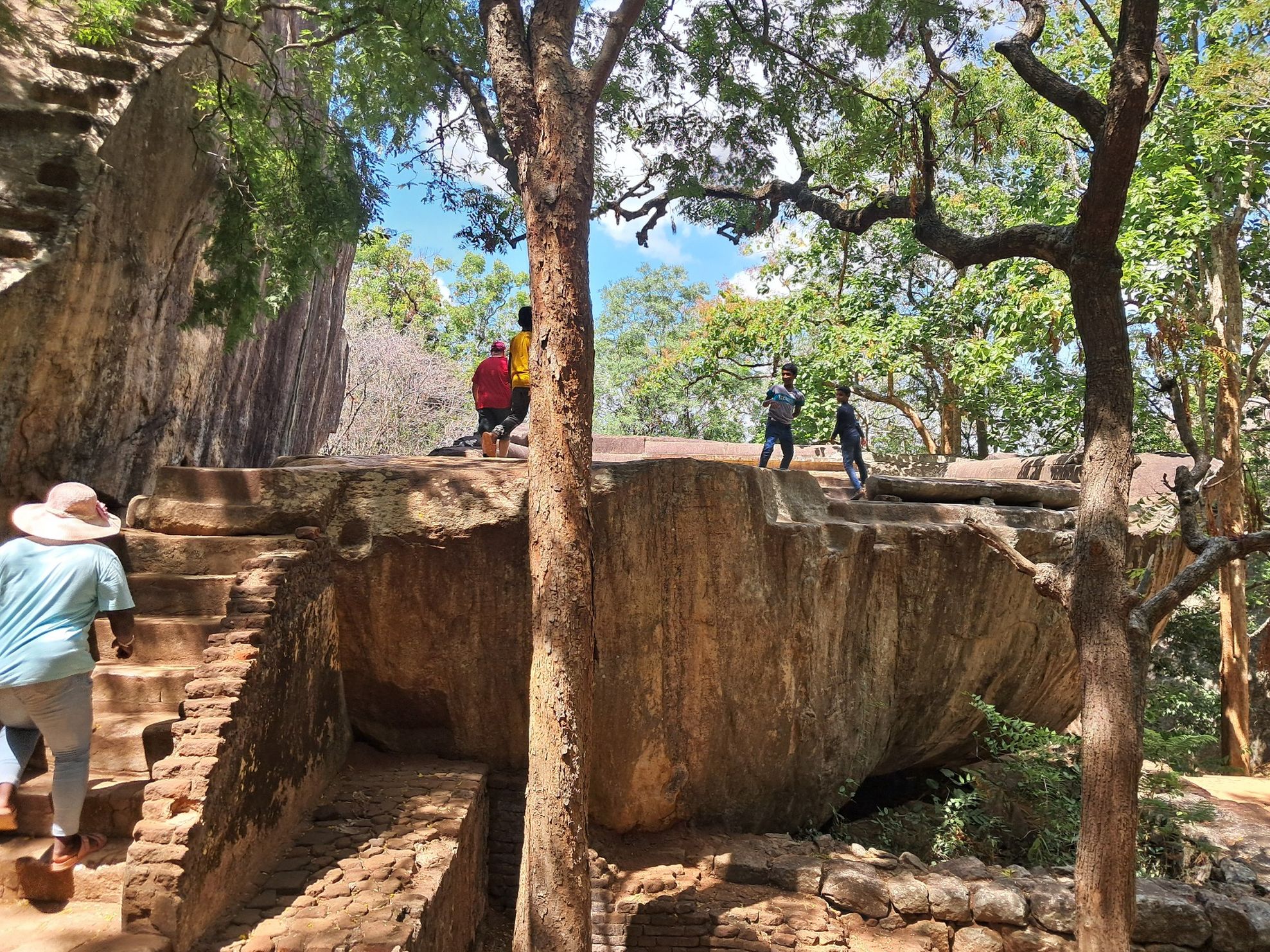
For a complete change of scenery, my On The Go Tours itinerary included a ravishing night at Udawalawe National Park. This revered national park is one of the best places to ogle the Sri Lankan Elephant, the biggest of all the Asian Elephants. There’s roughly 600 elephants here, in herds of up to 50. We took a captivating late afternoon safari ride, zipping down the red dusty roads of the parkland, to marvel over the wildlife. I was staggered to learn that the average Sri Lankan elephant guzzles down 200 litres of water a day! In addition to swooning over these mighty animals, the park is home to mongooses, jackals, water monitor lizards, lots of crocodiles, sloth bears, wild buffaloes, various snakes, spotted and sambar deer, plus the elusive leopard. We ticked off much of the checklist, including an intimate view of an enormous python, but the elusive leopard did indeed elude us.
Another star feature of my signature On the Go Tours experience was the sumptuous standard of hotels offerings. Our gorgeous roost in Dambulla was Jetwing Lake hotel, a brand new resort-style property where contemporary design is interspersed with splashes of Eastern influenced decor. This hotel had one of the biggest pools I have ever taken a dip in! Adjacent to the national park, we bedded down at the Grand Udawalawe Safari Resort. The artfully designed and spacious rooms featured beautiful hardwood flooring and sublime artworks depicting the wildlife of Udawalawe. It’s a popular spot for touring cricketers – including the Black Caps, who’s previous stays are memorialised with giant signed cricket bats.
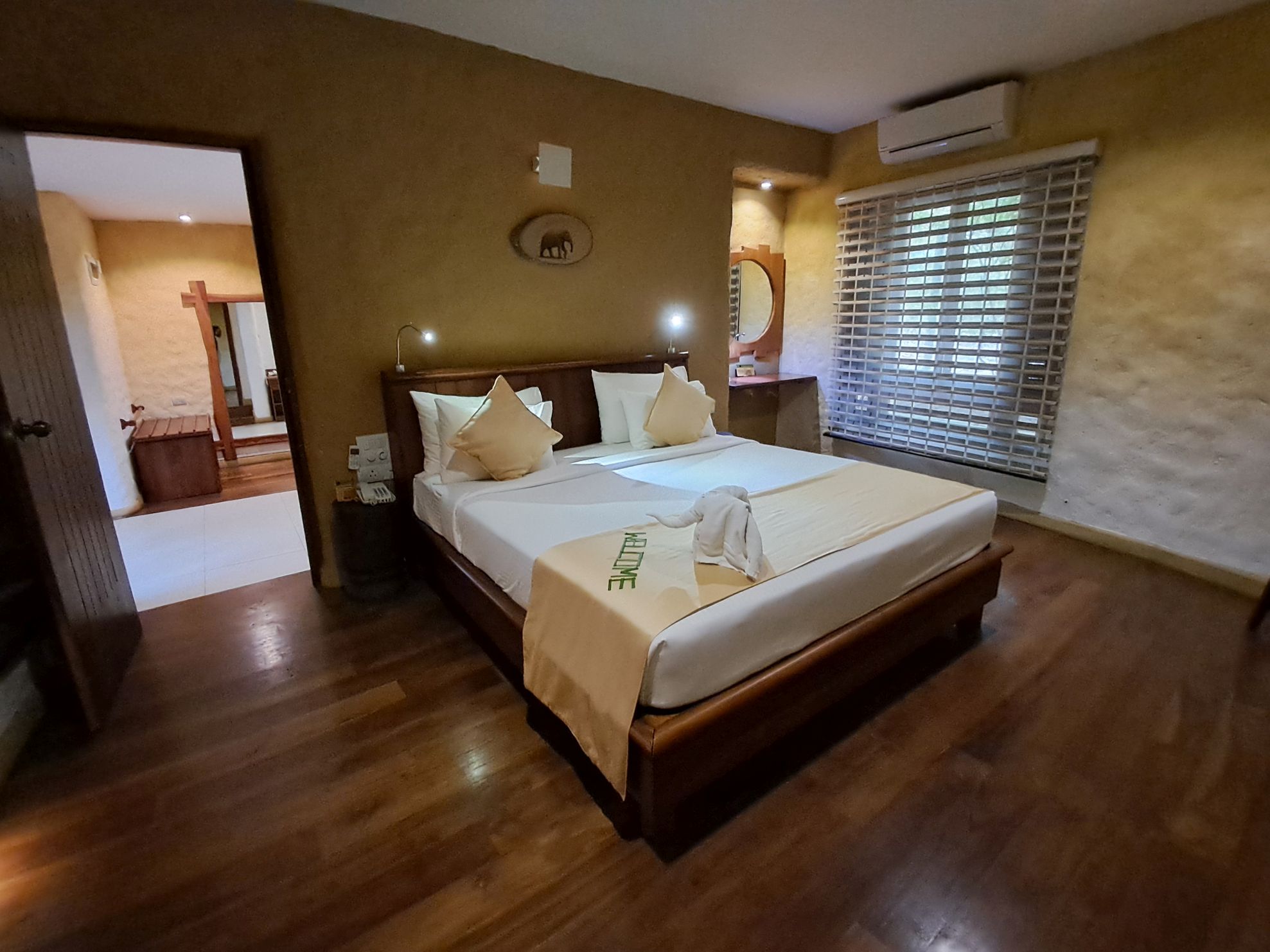
The lagoon-style outdoor pool was just the antidote to the deal to the heat of day. As was the case across all our hotels, the lavish buffet breakfasts featured a tantalising array of local curries. Kukul mas curry (chicken curry), Parippu (dhal curry) and Polos (green jackfruit curry) were my favourites. I am adamant that a belly full of curry is a sure-fire way to make your body more resilient to the rising mercury! The increase in your body temperature from eating spicy food makes you feel cooler, by reducing the difference between you and the surrounding air. That in turn, induces sweat, helping to cool the body down when the perspiration evaporates.
The World Heritage sites in the cultural triangle and the wonderful wildlife encounters were just some of the highlights from my 8 day Colombo, Caves and Kandy group tour with On the Go Tours, an award-winning provider of escorted group tours and private holidays. Spanning more than 70 destinations, On the Go Tours ensure expert local guides get you to the heart of your destination and deliver authentic and memorable experiences. Find the right tour and the right travel style at the right price for you. www.onthegotours.com
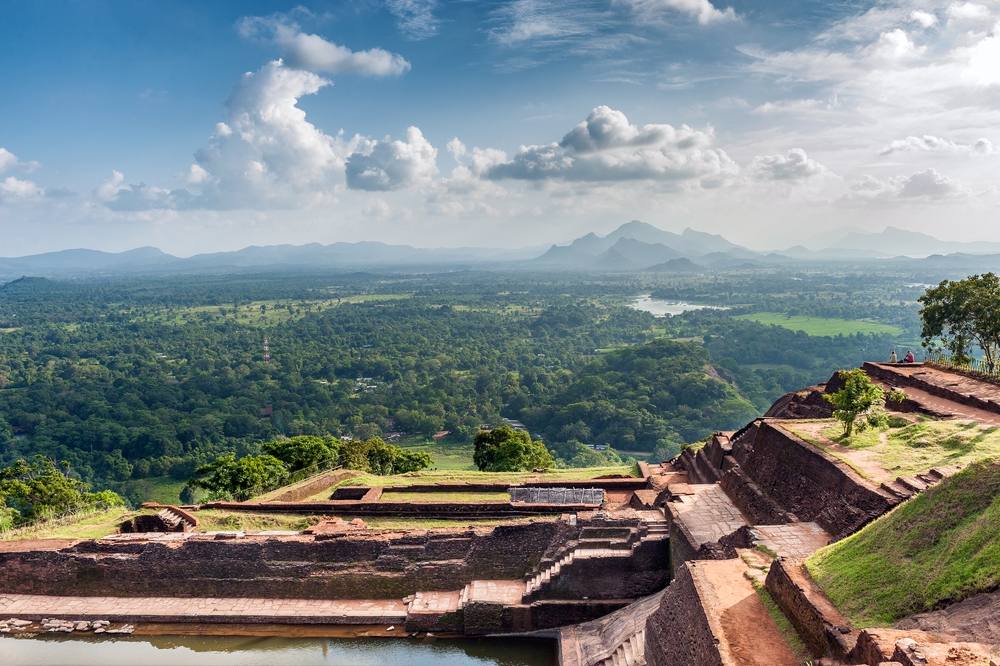
From New Zealand, it’s just a one-stop connection to Colombo with Singapore Airlines, on their daily services from Auckland and Christchurch to Singapore. Across all classes of travel, the award-winning carrier has not only fostered a world-beating reputation for its exceptional customer service and in-flight product, but also its innovation. Become a KrisFlyer member and enjoy complimentary in-flight WiFi. For best fares and seats to suit head to www.singaporeair.com
Mike Yardley is our resident traveller on Jack Tame Saturday Mornings.
Take your Radio, Podcasts and Music with you






